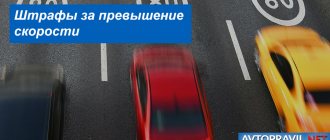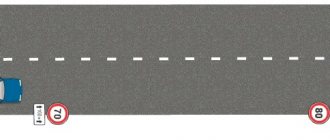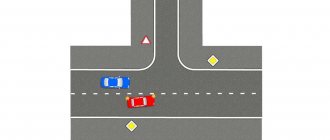Fines for average speed have been abolished - is this true?
In recent months, a myth has been increasingly circulating on the Internet that supposedly punishment for exceeding the average speed has been made illegal, and it is impossible to issue decisions with punishment if the speed recorded is not instantaneous.
It is not true. But the truth is that deputies not so long ago tried to promote a bill that would amend Article 1.5 of the Administrative Code, clarifying that evidence of a violation of traffic rules by a driver is not the calculation of his speed, but only the recording of such a violation in a specific place and at a specific time .
But this project has not yet been accepted, although progress is being made on it.
At the same time, not so long ago the Supreme Court ruled that drivers cannot be fined for their average speed. But this does not make such punishments unlawful and does not even change judicial practice at the level of district and regional courts. But we will definitely find out a working way to challenge such a fine.
Are fines “for average speed” legal?
What kind of average speed are you fined for?
First of all, I would like to understand the very concept of a “fine for average speed”. Let me tell you right away: there is no such fine. The incorrect name misleads many people. Fines are not issued for “average speed.” There is no average speed that must be maintained to remain law-abiding. You must adhere to the same speed limit established on a certain section of the road. What is different is the speed control method. In this case, instead of a very short section of the path within the view of one camera, a longer section is monitored and this is done using two cameras. The system calculates the average speed of a car on a section of road using a formula known to every high school student. In this way, it is established whether there was an excess of speed on the section or not. People are fined precisely for the fact of speeding, and not for “average speed,” as is often said. And as we know, the methods for establishing the fact of exceeding the established speed limit are not limited in any way by law.
Are the arguments of the plaintiffs challenging fines “for average speed” valid?
If there is no contradiction in the Code of Administrative Offenses in using the average speed method to measure speed, then what is the problem? There are several standard arguments that plaintiffs make.
The first is the absence of a specific time and place where the offense was committed. Indeed, the Code of Administrative Offenses states that an offense recorded using an automatic means of the FVF must indicate the time and place. When they say that when establishing the fact of speeding by recording the average speed, it is impossible to establish the exact time and place, they mean that time and place can only be point indicators. However, with speed things are different: speed exists only in dynamics. At a specific point, the physical body has no speed. Therefore, it seems logical and legitimate to determine the place and time of violation of the set speed as segments. If we take this logic to the absolute, then the results of even an ordinary camera that records speeding “in the moment” can be called into question. In reports about the ban by the Supreme Court of the Russian Federation of “fines for average speed,” they often write, referring to the decision in Mr. Bausov’s lawsuit: failure to indicate the exact location of the administrative offense or specifying it as a section of the road became the basis for cancellation. This is wrong. The Supreme Court of the Russian Federation indicated that the violation occurred from 19:05 to 19:41, the place where the offense was committed was a section of the road from 297 km of the M-1 Belarus highway in the city of Safonovo, Smolensk region to 226 km 602 m of the M-1 Belarus highway in the city Vyazma, Smolensk region. Let's not forget that the Supreme Court of the Russian Federation considered a specific complaint, a specific protocol and a court decision.
The second argument is that the section of road in the average speed measurement zone may fall under the jurisdiction of different courts. That is, if it is necessary to appeal a decision on a fine for speeding, established using the method of measuring speed along a segment, it will be impossible to decide which court to appeal to. The problem is purely legal. Consideration of a case within the proper jurisdiction is one of the foundations of justice. And this issue cannot be resolved chaotically. This factor must be addressed by judicious placement of cells within the jurisdiction of a single court. However, failure to comply with these requirements in a particular case does not make the use of this method illegal in principle.
Thus, indeed, in the case of disputes and appeals against fines issued on the basis of data from average speed cameras, the court needs to consider a different set of circumstances, compared to cases of speeding established by instant speed cameras, such as: speed limits within the segment or possible detours. However, all these circumstances, in the case of initially conscientious installation of equipment, must be thought out by responsible persons and be easy to install.
Is there a trend?
The latest lawsuit, which journalists refer to as a recent example of a successful challenge to a fine “for average speed,” from Mr. Chibisov, is far from being so recent: the ruling on it was made in April of this year. Another - the already mentioned last year case of Nikolai Bausov (it was pointed out for a long time as a precedent) by the Supreme Court of the Russian Federation was not actually canceled, but was returned for review. As part of the latter, the fine was left in force. Thus, there is no talk of any tendency towards the abolition of fines for speeding from cameras at average speed. Again, we are talking about a specific case. For example, in the Chibisov case, the court reproduced the position of the Supreme Court of the Russian Federation, despite the fact that the road section there was significantly smaller. But there the period for administrative liability has expired. The entry into force of a court decision does not make it a judicial precedent, since the position on challenging the act lies with the parties.
What's next?
The professional community has already made attempts to resolve these problems using legal instruments, answering the questions that drivers have accumulated. Thus, the ONF working group to protect the rights of motorists submitted a legislative initiative to the Ministry of Justice. But the latter’s position remains unclear; no concrete actions have yet been taken to clarify the state of affairs. At the same time, speeding is often the cause of accidents, as well as deaths on the roads, however, the fine for speeding is significantly lower than a harmless (not for the budget, of course) non-payment of parking.
- Pravo.ru
How do cameras work?
As of May 27, 2021, there are 2 auto-fixing tools that measure average speed:
- Avtodoriya complex,
- Boomerang is not a separate camera, but a means of calculating the average speed for a fine in Cordon systems.
This is what they look like:
In this case, the calculation is quite simple:
- the exact distance between two means of automatic violation detection is known,
- when you pass the first camera, it records the exact time,
- when passing the second camera, the time is also set,
- then, using a simple formula of dividing the distance by the period of time during which it was covered, the average speed is calculated - if it is higher than the permitted speed, then a fine is issued, which is sent to you by mail.
In the diagram, P1 and P2, respectively, are the location points of a pair of cameras, D is the exact distance between them, t is the measured travel time between the points. The average speed, in this case, is calculated as the distance divided by the time it travels.
It is legal?
On the one hand, the traffic rules state that the driver has no right to violate the established speed limit. Regardless of whether it is instant or average. But if the calculated average is higher than the permitted limit, then it can be reliably assumed that the driver has exceeded the permissible limit. This is true.
But the legislation does not accept such conventions. It (the 2021 legislation) contains regulations on how, when, in what cases and for what the traffic police can issue fines, how to appeal them and the deadlines for all this.
So, the illegality of fines specifically for average values can be judged by the following postulates of the Code of Administrative Offences.
The Code of Administrative Offenses says nothing about average speed
The violation event itself implies a one-time excess - that is, one fact of moving the car above the permitted speed. Therefore, the violation is considered not to last (it is considered momentary).
When calculating the average speed, it is not possible to reliably determine the fact of excess, as well as their number. Article 12.9 of the Code of Administrative Offenses refers to the fact of speeding, and not to the measurement of the average.
But if you only explain the illegality of the fine with this, then the complaint is unlikely to be satisfied, since this argument rarely convinces the judges.
Changing route
The car could change its route in such a way that the distance between the two cameras decreases. For example, when repairing a road and organizing a detour - such that it turns out to be more direct (instead of driving along the highway to bypass some village or village, drive through this village itself, for example).
Thus, the fine for average speed is essentially illegal and should be cancelled.
Incorrect measurement
The car could be moving at a much higher speed than the average speed recorded by the camera.
For example, you are driving at a speed of 160 km/h when the speed limit is 90. At the same time, you stopped for 5 minutes between a pair of auto-fixation cameras. In this case, the average will be, for example, 120 km/h, which forms the basis for attracting the owner of your car under Part 2 of Article 12.9 of the Code of Administrative Offenses (fine 500 rubles). But in fact, you were moving at a speed that falls under part 4 of this article.
Accordingly, the qualification of the standard of punishment is unlawful, and the fine for exceeding it is illegal.
Ban on fines for average speed
Another innovation concerns the note to Article 1.5 of the Administrative Code:
Note. The provisions of Part 3 of this article do not apply to administrative offenses provided for by Chapter 12 of this Code, and administrative offenses in the field of landscaping, provided for by the laws of the constituent entities of the Russian Federation, committed using vehicles or by the owner, owner of a land plot or other property, in the case of recording these administrative offenses using special technical means operating automatically, having the functions of photography, filming, video recording, or means of photography, filming, and video recording. Fixing the excess of the established speed of a vehicle on a section of the roadway based on the calculation of the average speed of the vehicle on this section, as well as recording a violation of the rules for the location of a vehicle on a section of the roadway based on recording the location of the vehicle at the beginning of the road is not evidence of an administrative offense. and at the end of this section, without recording the offense in a specifically established place and at a specifically established time.
This paragraph contains 2 innovations:
1. Fines for speeding, issued on the basis of calculating the average speed of a car, are considered illegal. That is, only fixing the instantaneous speed is allowed.
2. Fines for crossing markings recorded by two cameras are also considered illegal. We are talking about a situation where there is a continuous marking line on the road, and cameras are installed at the beginning and end of the road section. If a car passes under the first camera in one lane, and under the second camera in another lane, then somewhere between the cameras it has crossed a solid marking line. The bill proposes to consider such evidence illegal.
In addition, a new note has been added to Article 12.9 of the Administrative Code, which provides for fines for speeding:
Note. Bringing to administrative liability provided for in this article is permissible only in the case of recording the excess of the established speed of a vehicle in a specifically established place and at a specifically established time.
This paragraph once again states that fines for speeding can be issued only if there is an instantaneous value of the vehicle’s speed, and not based on the average value.
A working way to challenge a fine
Now let’s present the main argument, which, together with judicial practice, will help to successfully appeal fines for average speed.
And this argument is based on a simple logical chain of legislation:
- Article 24.1 of the Code of Administrative Offenses indicates that the case must be considered comprehensively and objectively,
- and norm 26.1 of the Code provides that the offense must be defined by the event itself,
- this event must include the time and place of speeding, since on the basis of this information the place of filing a complaint against a fine is determined,
- at the same time, it is the place and time of the commission of the offense, and not the consideration of the case, that are mandatory data for the possibility of correctly challenging the fine (Decree of the Supreme Court No. 36-AD19-3 of October 17, 2021).
Thus, the time and place where the speeding was committed are mandatory for a full consideration of the case. But for average speed fines, they are not specific. So, if exactly the section of the road from and to is indicated, then it may have jurisdiction over two or more traffic police departments or courts. And this is the main argument when challenging the legality of punishment for average speed.
The court overturned the fine for average speed: what does this mean for drivers
The Supreme Court sided with a motorist who was punished for exceeding the average speed on a specific section of the road. Due to a fine of 500 rubles. the driver was on trial for about a year - the desire to prove his innocence became a matter of principle for him. Experts do not agree with the decision and call such fixation the most effective way to catch reckless drivers.
Nikolay Bausov in his Volkswagen Tiguan was caught in the lens of the Boomerang VS0001/17-8 camera, measuring the average speed, while traveling around the Smolensk region on August 17, 2021. The cameras photographed him in the period from 19:05 to 19:41 on the section from the 297th km (city of Safonov) to the 226th km (city of Vyazma) of the M-1 Belarus highway in the Smolensk region.
According to the case materials, the driver, in violation of traffic rules, exceeded the established speed of the vehicle by 25 km/h: instead of the required 90 km/h, he drove at a speed of 115 km/h. He was brought to justice on the basis of Part 2 of Art. 12.9 of the Administrative Code - “Exceeding the established speed of a vehicle by more than 20, but not more than 40 km/h,” which is punishable by an administrative fine of 500 rubles.
Bausov tried to challenge the fine first in the district court of the Smolensk region, and then in the regional court. He insisted that the official who made the decision did not establish the specific time and place of the violation. “The resolution indicates the average speed of my car, which is not provided for by the Code of Administrative Offenses,” said the driver. However, all authorities upheld the punishment, and then the motorist appealed to the Supreme Court, which accepted his arguments.
“The event of an administrative offense includes the time and place of its commission,” the Supreme Court said in its decision. — These circumstances are included in the subject of proof and are subject to clarification in the case of an administrative offense. Materials generated by technical means operating in automatic mode must contain the specified information.”
The Supreme Court indicated that the administrative offense provided for in Part 2 of Art. 12.9 of the Code of Administrative Offenses is not considered to be ongoing, that is, it occurs simultaneously. Therefore, the resolution must contain the exact time and place of the offense. And the indication of a separate section of the road as the place where an administrative offense was committed, according to the Supreme Court, is unacceptable. The court was also not satisfied with the traffic police inspector’s method of calculating the average speed.
“It follows from the official’s decision that speeding was determined by calculating the average speed of the vehicle. At the same time, the car could have taken a different route,” the decision says. — That is, having passed the first video recording camera without exceeding the speed limit, the applicant could proceed to another section of the road - for example, to a backup. And from there, drive onto the road in front of the second video camera, which he would have passed without exceeding the speed limit.”
The judge also considered that part of the time the vehicle could have simply been parked, and the section of road between the installed cameras could have been covered even at a higher speed than indicated in the official’s decision (115 km/h). This would mean more serious penalties for speeding. As a result, the Supreme Court returned the case for a new trial to the Vyazemsky District Court.
The traffic police have already expressed their dissatisfaction due to the fact that the courts are still making different decisions on average speed. In particular, the head of the department for ensuring law enforcement activities of the Main Traffic Safety Inspectorate of the Ministry of Internal Affairs of Russia, Andrei Klimenko, at a seminar on traffic safety, indicated that the Supreme Court had already dealt with exceeding the average speed and made other decisions: “This practice, such as fines for average speed, has existed for a long time and has already went through the Supreme Court. The same judge made different decisions on the same situations - in 2014 and in 2021.”
In turn, Deputy Head of the State Traffic Safety Inspectorate Oleg Ponaryin noted that traffic police officers do not always collect high-quality evidence, and there is no point in commenting on a specific decision of the Supreme Court. “A decision is a decision, if it is illegal, it will be appealed. We have no reason for this. There are a lot of subtleties in a court case,” Ponaryin said.
The former head of the State Traffic Safety Inspectorate of the Ministry of Internal Affairs for Tatarstan, Rifkat Minnikhanov, earlier in a conversation with Autonews.ru refuted arguments that a speeding driver can escape punishment if he goes to a gas station or a cafe.
“Here is a driver driving at an average speed of 150 km per hour. Stopped at a cafe. Moreover, its path passes through 144 sections, which cover 100 cameras. Yes, he can sit out in the first section and, perhaps, will not receive a fine. But he won’t refuel or drink coffee all 144 times. The driver will still drive most of the way without stopping, and every violation will be recorded - it’s practically impossible to bypass total control,” explained Minnikhanov.
An expert in the field of photographic and video recording of violations, director Sergei Laskin called complexes that measure average speed “an ideal way to catch violators.” The main thing is that the equipment is certified and correctly configured.
“There may actually be two cameras on the section - one records the entry, the second - the exit. There is a cascade method - for example, three cameras for two sections and so on,” Laskin told Autonews.ru. “And this is the most effective way to fight reckless drivers.” Now information about every regular camera is available in navigators. You can drive 150 km/h, brake in advance and move on. In this case, the driver behind may not react, crash, and an accident will occur. And knowing that slowing down for a while is useless and the fine will still come, drivers will simply lose the incentive to violate.”
The expert calls the arguments that in order to record a violation the exact time and place must be indicated as untenable. To avoid different interpretations, he proposes to amend the Code of Administrative Offenses and specify the exact conditions for issuing fines. Laskin does not consider the stories of drivers who drove off the highway to be a serious argument. “If such a violator drives off the road, he simply will not receive a fine. This is one out of a thousand. But everyone else will be punished,” the expert explained.
Government officials are increasingly criticizing such fines. Thus, the State Duma Committee on State Construction supported a bill providing for the abolition of fines for exceeding the average speed. This document was developed by deputies of the LDPR faction, who called this method of collection incorrect. As one of the authors of the initiative, Yaroslav Nilov, noted, the concept of “average speed” does not exist in the traffic rules. In his opinion, the use of this method is incorrect, since in order to bring to administrative responsibility it is necessary to record a violation in a specific place and at a specific time.
In turn, the first deputy chairman of this committee, Vyacheslav Lysakov, also noted that people receive fines without any legal grounds, since the concept of “average speed” is not in the rules or in the Administrative Code.
Autonews
Share link:
- Click here to share content on Facebook. (Opens in a new window)
- Click to share on WhatsApp (Opens in new window)
- Click to share on Telegram (Opens in new window)
- Click to share on Twitter (Opens in new window)
Similar
Judicial practice 2021
It is the Supreme Court Resolution, referred to above, that is essentially fundamental when filing a complaint against a fine for average speed. And it is this decision that should be referred to in the complaint itself, since lower courts are obliged to be guided by the decisions of the Supreme Court.
But this does not mean that they are obliged to make the same decision, so you should not count on the fact that this will lead to a 100% cancellation of the fine. But still, it is this judicial practice that is more convincing for 2021.
We explained in more detail how to challenge a speeding fine in the article about such an appeal. Now you know what arguments need to be given when making a decision based on measuring the average speed. We also recommend reading the article about the general procedure for canceling traffic police fines.











